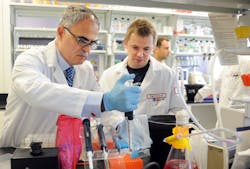LVDT Position Sensors: Connectors vs. Lead Wire
Connectors and lead wires provide the electrical connection between the coils of an LVDT position sensor and signal conditioning electronics. Choosing between a connector and lead wires, when specifying an LVDT or other sensor, often depends on the application and its environment. Below are some helpful tips to guide you in deciding whether to specify a connector or lead wires for your next sensor.
Pros and Cons of Wire Leads and Connectors
LVDT sensors are most commonly specified with lead wires as they are generally less expensive than connectors and easy to use, providing a simple connection to signal conditioning electronics for bench-top testing. In some cases, lead wires can offer expanded operating ranges in both temperature and pressure. For example, lead wires are the preferred electrical connection for sensors used in high pressure, in-cylinder hydraulic applications or when operating temperatures exceed 400°F.
Lead wire sensitivity, however, is a potential drawback to its use as the wire can break if not handled carefully during installation. Long runs of leads also can be cumbersome and complicated to install. In addition, lead wires are susceptible to picking up noise that can affect interpretation of signals by the conditioning equipment, ultimately reducing the accuracy of the sensor output.
Independent of wiring, sensors with connectors are easier to install and uninstall. When reinstalling a sensor, connectors can simply be unplugged or plugged into while lead wires must be broken and often repaired.
Connectors also can be specified with shielded cable assemblies to create longer distances between the LVDT linear position sensor and electronics, which is especially important when sensors must perform in harsh environments, as cabling has lower resistance and shielding that protects against interference from outside sources.
If wires are broken or pulled on the cable assembly, only the cable assembly has to be replaced as the LVDT sensor will otherwise remain in working order. Breaking or stripping a lead wire by pulling on it too hard makes the sensor non-repairable, requiring the purchase of a replacement sensor. Through the use of connectors, LVDT sensors can be hermetically sealed, offering ingress protection ratings to IP-68.
On the downside, connectors can be bulky and difficult to fit into tight spaces or on LVDTs with small package size requirements.
Best Applications for Wires and Connectors
In industrial, dirty, and subsea environments, glass-sealed connectors are recommended as a way to make the electrical connection while maintaining the hermetic seal. This protects the LVDT from dust, dirt, jetting, or submersion. Applications that require a hermetically sealed IP-67 or IP-68 LVDT will generally have a connector.
In industrial and OEM applications where a single piece of equipment can use various sensors, cable assemblies can save time by centralizing wiring to a cable harness. And by using connectors with longer cable assemblies, AC-operated LVDTs can operate under hostile conditions while electronics are located in a more benign environment. Cables connect the linear position sensors with remotely located electronics that power the sensors, amplify and demodulate their output.
For hydraulic in-cylinder applications where pressures can reach 20,000 psi and higher, using leads on vented LVDTs allow for equalized pressure on all components of the sensor. For indoor test and measurement applications in ambient environments, leads also offer a simple connection from the LVDT to associated electronics.
For additional application recommendations, refer to Table 1.
Tips in Determining Best Electrical Connection
In determining the best electrical connection for an LVDT sensor, gather facts on the environment where the sensor will be placed as different elements can effect performance.
- Temperatures in excess of 400°F: leads may be better suited
- High pressure: in conductive fluids like water: require a connector; in fluids that are not electrically conductive like hydraulic fluid, leads can be used
- Dust/Humidity: glass-sealed connectors offer better environmental protection against heavy dust, humidity and submersion
- Vibrations: If the sensor will be exposed to constant shock and vibration over a long period of time, leads or a screw-on connector offer the best options
Michael Marciante is an Applications Engineer at Macro Sensors
